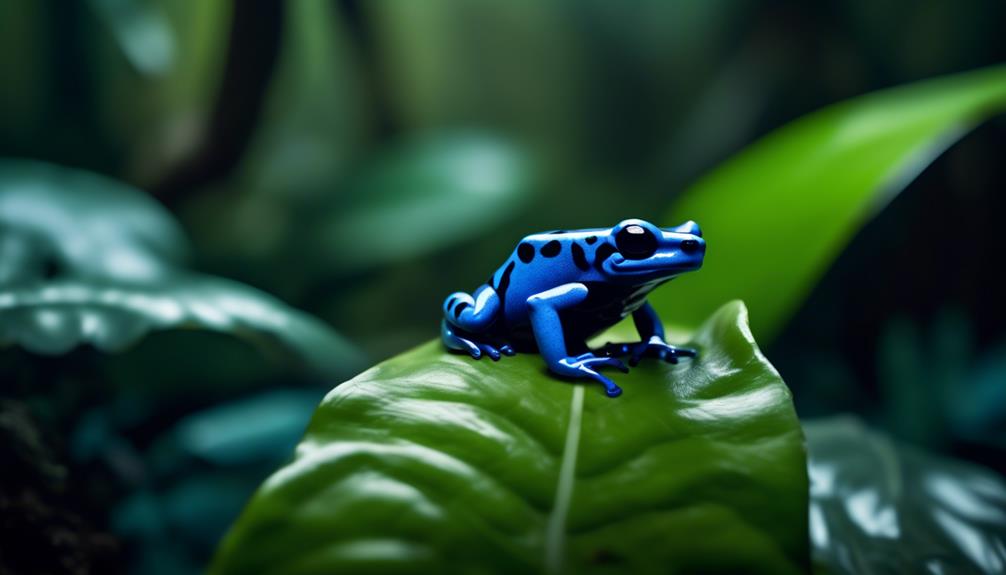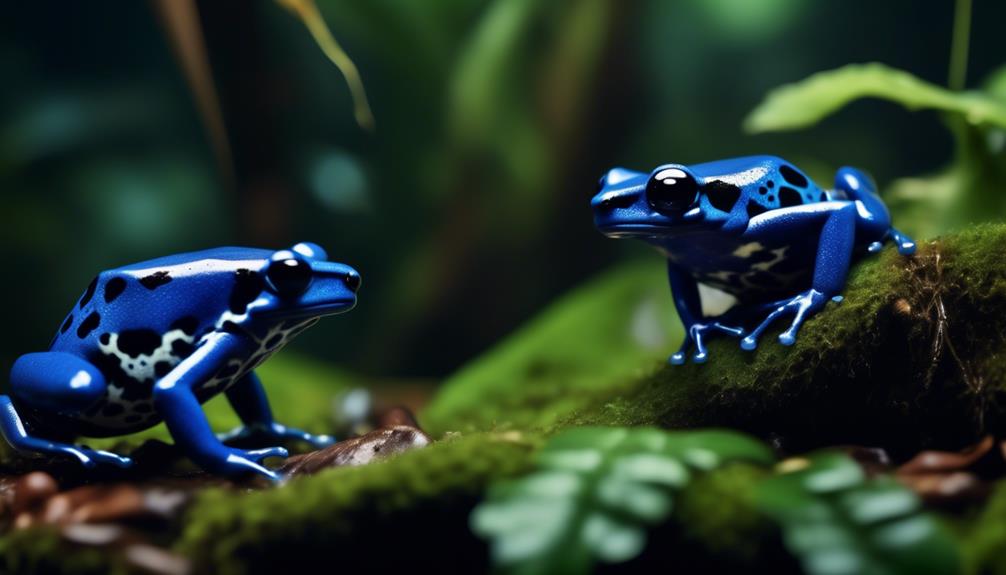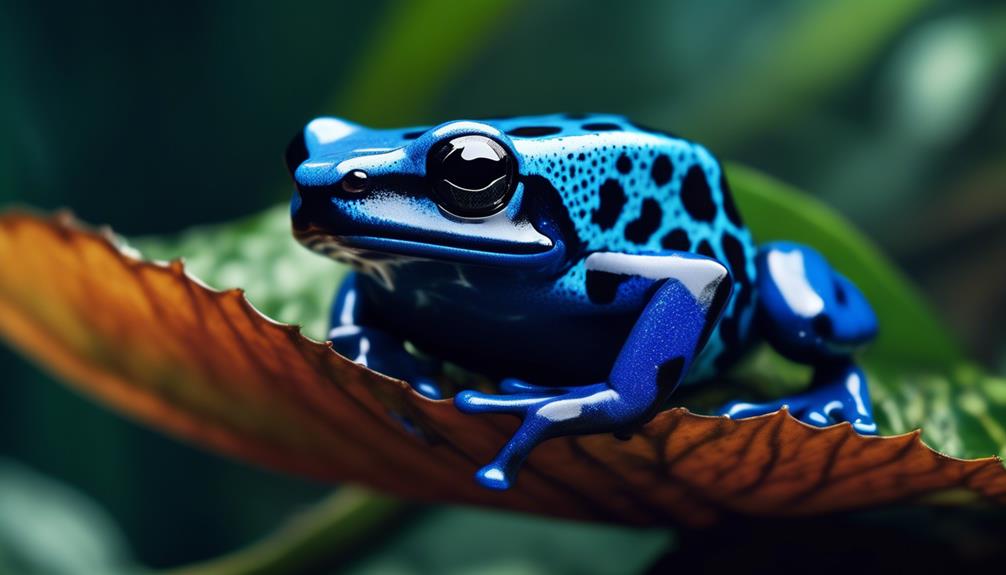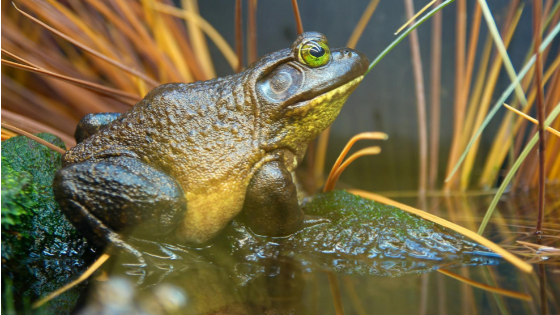
The blue poison dart frog, a captivating creature native to the rainforests of Central and South America, possesses a striking appearance that has intrigued researchers and enthusiasts alike.
With its vibrant blue skin and unique black spots, this medium-sized amphibian displays a warning signal to potential predators.
However, its territorial and aggressive nature adds an intriguing layer to its behavior. From intense physical fights during breeding season to the male’s responsibility for caring for the eggs and tadpoles, the blue poison dart frog showcases a complexity that demands further exploration.
Moreover, understanding its feeding habits and proper care in captive environments provides valuable insights into the complexities of this fascinating species.
Key Takeaways
- The blue poison dart frog is a medium-sized frog with bright blue skin and unique black spots.
- It is territorial and aggressive towards other frogs and predators.
- The male takes care of the eggs and tadpoles during reproduction.
- The blue poison dart frog feeds on fire ants and insects, and it can be poisonous due to consuming insects with poisonous chemicals.
Physical Characteristics
The blue poison dart frog possesses distinct physical characteristics that distinguish it from other frog species. It is a medium-sized frog, weighing about 8g (0.28oz) and growing to a length of 3.0–4.5cm (1.2–1.8in). The females are slightly larger, measuring about half a centimeter longer than the males.
What sets the blue poison dart frog apart is its bright blue skin, which serves as a warning to predators. Additionally, each frog has unique black spots on its skin, adding to its distinctive appearance. These physical traits contribute to the frog’s recognition and help keep it safe in its natural habitat.
Unique Warning Coloration

With its vibrant blue skin, the blue poison dart frog showcases a unique and distinctive warning coloration. This striking color serves as a visual cue to potential predators, signaling that the frog is toxic and should be avoided. The blue coloration is believed to be a result of the frog’s diet, which consists of small invertebrates that contain toxic compounds. This toxic nature is further emphasized by the contrasting black spots that adorn the frog’s skin, creating a visually striking pattern. To highlight the blue poison dart frog’s warning coloration, here is a table showcasing its physical characteristics:
| Physical Characteristics | |
|---|---|
| Size | 3.0–4.5cm (1.2–1.8in) |
| Weight | 8g (0.28oz) |
| Unique Features | Vibrant blue skin |
This table provides a concise overview of the frog’s physical characteristics and emphasizes the significance of its warning coloration.
Terrestrial Behavior

To further understand the behavior of the blue poison dart frog, it is important to examine its terrestrial tendencies and how they contribute to its survival in its natural habitat.
As a terrestrial animal, the blue poison dart frog stays close to water sources. It navigates its surroundings by hopping around in short leaps, actively searching for insects to feed on.
These frogs exhibit territorial behavior and are aggressive towards their own species and others. They use calls, chases, and wrestling to ward off intruders and protect their territory. This behavior ensures that they have access to sufficient food resources and minimizes competition.
Habitat Preference

In order to thrive, the blue poison dart frog displays a clear preference for specific habitats within its natural range. These frogs are primarily found in the tropical rainforests of Central and South America, particularly in areas with high levels of rainfall and humidity.
They are typically found near water sources such as streams, rivers, and ponds, as they require these aquatic environments for breeding and laying their eggs. Additionally, the blue poison dart frog tends to inhabit areas with dense vegetation, such as leaf litter or low-lying shrubs, which provide them with ample cover and protection from predators.
These habitat preferences ensure that the blue poison dart frog has access to the necessary resources and conditions for its survival and reproductive success.
Hunting Techniques

The blue poison dart frog’s successful survival in its preferred habitats can be attributed to its unique hunting techniques. These techniques not only enable the frog to find food but also ensure its safety from predators. The hunting techniques of the blue poison dart frog include:
- Ambushing prey: The frog patiently waits for insects to come within reach before striking with lightning-fast precision.
- Sticky tongue: Its long, sticky tongue allows the frog to snatch prey from a distance, ensuring a successful catch every time.
- Mimicry: The blue poison dart frog mimics the coloration of its toxic relatives, fooling predators into thinking it is also poisonous.
- Poisonous skin: The frog’s bright blue skin serves as a warning to predators, indicating its toxic nature and deterring them from attacking.
These hunting techniques showcase the adaptability and resourcefulness of the blue poison dart frog, making it a fascinating species to study.
Aggressive Territorial Behavior

Aggressive territorial behavior is a prominent characteristic of the blue poison dart frog. It fiercely defends its territory against intruders. These frogs are highly territorial and will aggressively confront not only members of their own species but also other intruders.
They use various tactics such as calls, chases, and wrestling to ward off potential threats. The blue poison dart frog’s aggression is rooted in its need to protect its resources, including food sources and potential mates. This behavior ensures that the frog’s breeding grounds and food supply remain secure.
The bright blue skin of the frog serves as a warning to potential intruders, signaling its toxicity and deterring them from encroaching on its territory. Overall, the blue poison dart frog’s aggressive territorial behavior is essential for its survival and reproductive success.
Breeding Season and Courtship

During the breeding season, the blue poison dart frog engages in intricate courtship rituals to ensure successful reproduction. These rituals are not only fascinating but also play a crucial role in the continuation of their species.
Here are some key aspects of the blue poison dart frog’s courtship behavior:
- Elaborate vocalizations: Males produce unique calls to attract females, creating a symphony of sounds in the rainforest.
- Colorful displays: Males showcase their vibrant blue skin and unique black spots, captivating the attention of potential mates.
- Physical contests: Females physically fight over a male, testing their strength and determination.
- Mating behavior: Once a female has successfully chosen a mate, they engage in amplexus, where the male grasps the female’s back and fertilizes the eggs externally.
These courtship rituals highlight the dedication and resilience of the blue poison dart frog in their quest for successful reproduction.
Mating Rituals

Blue poison dart frogs engage in intricate mating rituals to ensure successful reproduction. These rituals involve a series of behaviors and interactions between males and females. To provide a clear understanding of these rituals, here is a table outlining the key steps in the mating process:
| Mating Rituals | ||
|---|---|---|
| 1. Male calls | 2. Female approaches | 3. Female physically fights over male |
| 4. Male wrestles with female | 5. Male fertilizes eggs | 6. Male carries tadpoles on his back |
During mating season, males produce calls to attract females. Once a male catches the attention of a female, she will approach him. However, the competition for mating can be intense, leading to physical fights between females over a male. To establish dominance, the female will wrestle with the male. Once the male successfully fertilizes the eggs, he takes on the responsibility of carrying the tadpoles on his back until they hatch. These mating rituals ensure the continuation of the blue poison dart frog species.
Parental Care

The blue poison dart frog exhibits remarkable parental care to ensure the survival of its offspring. This level of dedication is truly awe-inspiring and serves as a testament to the frog’s commitment to its young.
The following bullet list highlights the extraordinary behaviors displayed by these frogs:
- The male frog diligently guards the eggs, ensuring their safety from predators and environmental threats.
- He keeps the eggs hydrated by transporting water droplets to the nest, preventing dehydration.
- The male also defends the developing tadpoles by providing them with unfertilized eggs, which serve as their sole source of nourishment.
- Once the tadpoles hatch, the male carries them individually on his back to nearby water sources, where they can continue their development.
These incredible acts of parental care showcase the blue poison dart frog’s dedication to the well-being and survival of its offspring.
Diet and Feeding Habits

After showcasing remarkable parental care, the blue poison dart frog’s next focus turns towards its diet and feeding habits. These frogs primarily feed on fire ants and insects, which make up the majority of their diet. However, what sets them apart is their ability to consume insects with poisonous chemicals, making them poisonous themselves. This is due to the presence of toxic alkaloids in their skin, which they obtain from their diet. In addition to fire ants, the blue poison dart frog also preys on a variety of other insects, including beetles, flies, mites, spiders, termites, maggots, and caterpillars. In captivity, their diet consists of fruit flies, pinhead crickets, rice flour beetle larvae, isopods, and springtails. Providing a suitable habitat with the proper temperature and humidity is crucial for their captive care.
| Diet | Feeding Habits |
|---|---|
| Fire ants | Predominantly feeds on fire ants |
| Insects | Consumes insects with poisonous chemicals |
| Beetles, flies, mites | Preys on a variety of other insects |
| Spiders, termites, etc. | Diverse range of prey items |
Prey Selection

In regards to its feeding habits, the blue poison dart frog demonstrates a selective approach when it comes to prey. This fascinating creature carefully chooses its prey, ensuring that it only consumes the most suitable and nutritious options.
The prey selection of the blue poison dart frog is characterized by:
- A keen eye for fire ants, insects, beetles, flies, mites, spiders, termites, maggots, and caterpillars, which form its primary diet.
- A preference for prey items that may contain poisonous chemicals, contributing to the frog’s own toxicity.
- A discerning taste for specific types of small insects such as fruit flies, pinhead crickets, rice flour beetle larvae, isopods, and springtails.
- An ability to adapt to captive care conditions, necessitating the provision of the appropriate habitat and a variety of suitable prey options.
These selective feeding habits not only showcase the blue poison dart frog’s remarkable survival skills but also highlight its intricate relationship with its environment.
Feeding in Captivity

When considering the feeding habits of the blue poison dart frog in captive care, it becomes evident that providing a suitable diet is crucial to ensure their well-being.
In captivity, these frogs primarily feed on fruit flies, pinhead crickets, and other small insects. Additional prey items may include rice flour beetle larvae, isopods, and springtails. It is important to mimic their natural diet as closely as possible to maintain their health and vitality.
Feeding should be done regularly, taking into account the frog’s size and appetite. It is essential to ensure that the prey items are properly gut-loaded and dusted with essential nutrients, such as calcium and vitamin D3, to prevent any nutritional deficiencies.
Proper Care in Captive Environments

To ensure the well-being of blue poison dart frogs in captive environments, it is crucial to provide proper care and attention. These delicate creatures require specific conditions to thrive and stay healthy. Here are some key considerations for their care:
- Habitat: Creating a suitable enclosure with adequate space, temperature, and humidity is essential for the well-being of blue poison dart frogs.
- Feeding: Providing a varied diet of fruit flies, pinhead crickets, and other small insects is vital to meet their nutritional needs.
- Cleaning: Regular cleaning and maintenance of the enclosure are necessary to prevent the buildup of waste and harmful bacteria.
- Minimizing Stress: Avoiding unnecessary handling of the frogs helps reduce stress and potential harm. It is important to observe them from a distance and provide a quiet environment.
Frequently Asked Questions
What Is the Lifespan of a Blue Poison Dart Frog in the Wild?
The lifespan of a blue poison dart frog in the wild is typically around 4-6 years. However, with proper care in captivity, they can live up to 10 years or more.
How Do Blue Poison Dart Frogs Communicate With Each Other?
Blue poison dart frogs communicate through calls, chases, and wrestling to establish territories and ward off intruders. Males produce calls to attract females during mating season, while females physically fight over a male.
Are Blue Poison Dart Frogs Found in Any Other Colors Besides Blue?
Blue poison dart frogs are primarily known for their bright blue skin, which serves as a warning to predators. While blue is the most common color, some populations may exhibit variations in coloration, including green, yellow, or black.
What Are the Predators of the Blue Poison Dart Frog?
The predators of the blue poison dart frog include snakes, birds, spiders, and certain mammals. These predators are attracted to the bright blue coloration, but they are also cautious of the frog’s toxic skin secretions.
Can Blue Poison Dart Frogs Be Kept as Pets?
Blue poison dart frogs can be kept as pets, but they require a suitable habitat with proper temperature and humidity. Careful handling is necessary to prevent stress and potential harm to the frogs.
What are the differences and similarities between the Blue Poison Dart Frog and the Golden Poison Frog in terms of toxicity and behavior?
The deadly golden poison frog and the blue poison dart frog may look similar, but they have distinct differences in toxicity and behavior. The deadly golden poison frog is the most toxic frog, while the blue poison dart frog is less toxic. Behavior-wise, both frogs display similar warning signals to predators.
Conclusion
In conclusion, the blue poison dart frog is a fascinating species native to the rainforests of Central and South America. Its vibrant blue coloration serves as a warning to predators, while its territorial and aggressive nature becomes evident during breeding season.
The male’s responsibility for caring for the eggs and tadpoles further adds to the complexities of this creature. Proper care in captive environments is crucial to ensure their well-being.
Overall, the blue poison dart frog is a captivating amphibian that continues to intrigue researchers and enthusiasts alike.



